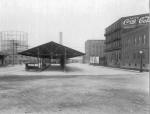Interstate 81 | |||
In April of 1958, the Post-Standard and City officials were alarmed to learn that the state planned an elevated north-south highway through the center of town. It took their best efforts to move the route three blocks west, but they could not stop it. | |||
(Click thumbnail image for enlargement) In early April of 1958, information was leaked to the Post-Standard that the state planned an elevated highway through the center of town. The paper immediately initiated an aggressive public relations campaign against this plan. Mayor Anthony A. Henninger joined the Post-Standard campaign a few days later. The mayor told the Post-Standard he had learned that elevated highways "have ruined other cities." But the mayor said state officials had been "very cooperative" and he was sure he could persuade them to change their plans. City officials had long assumed the state was planning something for Syracuse like the graceful parkways being built around New York City at that time. They expected the new north-south highway to be either at grade or below grade, and not through the center of the city. The mayor said an elevated highway would completely "imprison" the valuable downtown district and prevent future growth. He said the city engineer and other "influential civic and government leaders" were "definitely opposed" to such a plan. In fact the Post-Standard conducted its own survey of unnamed "influential" city leaders and found them all to be opposed City engineer Potter Kelley said "Anything elevated is bad. I would oppose such plans." The 15th Ward supervisor said "I very definitely object to that kind of plan. Clear thinking in any community is opposed to elevation, except where it is absolutely necessary." The president of the Common Council said, "I'm definitely opposed to such a highway plan. It defaces the appearance of the city. We have enough elevated structures now." He said other councilors he had spoken with were also opposed to the elevated highway proposal.
A Post-Standard editorial on April 13th, 1958, was confident that Governor Harriman would protect the interests of Syracuse by stopping plans for an elevated highway. "He certainly would never agree to an elevated highway that would bisect a large area Syracuse has set aside for urban renewal at a high level." The editorial goes on to say the elevated highway would wreck the city's plans for a "wide, landscaped avenue" to link downtown with the State Medical Center. The elevated highway would block access to the medical center, "...Syracuse University and the whole eastern residential area." The Post-Standard said "It requires little exercise of the imagination to realize what endless damage would be done...By shutting off light and air, by depressing property values and by their ugliness, these gruesome barriers cause and spread blight." So what happened? The state's original plan had routed the elevated highway down Townsend street. The city successfully petitioned the state to move the highway three blocks to the east, where we find it today. Even with this new route, Mayor Henninger maintained that if the highway must be elevated the city would prefer that it be moved to the edge of town. The state was resolute in its plans. Time was of the essence, they kept saying, and decisions had to be made quickly. The new federal Interstate Highway bill meant the U.S. government would be picking up 90% of the cost of highway construction with the state paying most of the remainder. The city had little leverage and, ultimately, couldn't pass up the vast federal funds, and jobs, that accompanied the project. By the mid-1960s, sections of I-81 north and south of the city had already been completed. Interstate traffic was pouring off the highway at either end of town and winding its way through the city to complete the north-south journey. At this point city officials couldn't wait to see the interstate completed, in any form. The plan also had its supporters. Worried about losing retail business to the suburbs, some downtown business leaders favored a route through downtown. They thought a North-South highway, with exits convenient to downtown, would bring retail activity and customers into the city. Instead, the burgeoning suburbs soon developed their own retail centers. Over time, the major downtown retailers either moved to the suburbs or went out of business. | |||


